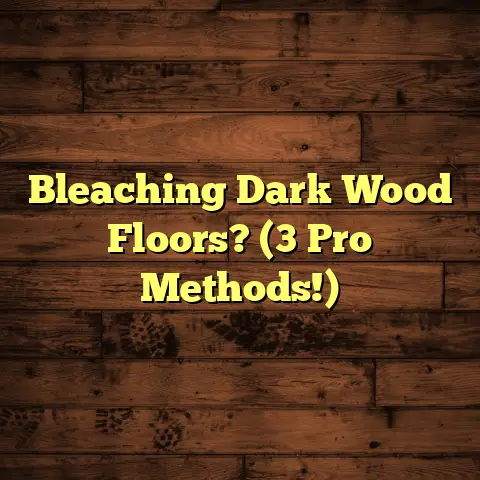Carpet Grippers on Concrete? (5 Subfloor Fails!)
I’m a flooring contractor with over 15 years in the game, and let me tell you, I’ve seen it all when it comes to flooring installations. One thing I’ve noticed lately is the increasing concern about allergies and respiratory issues.
It’s a real problem, and a lot of it boils down to indoor air quality.
Think about it: we spend so much time indoors, and if our homes are filled with allergens, it can really impact our health. Carpets, while comfy and stylish, can be major culprits. They trap dust mites, mold spores, pet dander – you name it!
Now, enter carpet grippers.
These little guys are designed to hold your carpet in place, especially on concrete floors. But here’s the big question: are they really a good idea if you’re worried about allergies? That’s what we’re diving into today.
Let’s get started!
Understanding Carpet Grippers
So, what exactly are carpet grippers?
Simply put, they’re strips of material, usually wood or metal, with angled pins or tacks that grip the carpet backing. They’re installed around the perimeter of a room and hold the carpet taut, preventing wrinkles and movement.
Think of them as tiny, tenacious teeth for your carpet!
There’s a whole range of carpet grippers out there, each designed for different flooring types. You’ve got your standard wood grippers, metal grippers for high-traffic areas, and even specialized grippers for concrete floors.
The key is choosing the right one for your specific situation.
Now, let’s talk installation on concrete. It’s a bit different than installing on a wooden subfloor. You’ll need a few key tools:
- A hammer drill (concrete is tough!)
- Concrete nails or screws
- A measuring tape
- A chalk line
- Safety glasses (always!)
The process involves measuring, marking the perimeter, drilling pilot holes, and then securing the grippers to the concrete with nails or screws. It’s crucial to get this right, or you’ll end up with loose grippers and a wobbly carpet.
One of the biggest advantages of using carpet grippers is stability. They keep your carpet firmly in place, preventing slips and falls. This is especially important if you have kids or elderly folks in the house.
Plus, a well-secured carpet looks much neater and more professional.
The Role of Subfloors in Indoor Air Quality
Alright, let’s shift our focus to subfloors. What exactly is a subfloor, and why should you care?
Well, the subfloor is the foundation of your flooring system. It’s the layer directly beneath your finished floor, providing a stable and level surface. In our case, we’re talking about concrete subfloors.
Concrete subfloors can significantly impact your indoor air quality, primarily through moisture control. Concrete is porous, meaning it can absorb moisture from the ground.
If that moisture isn’t properly managed, it can lead to mold growth, which is a major allergen trigger.
Now, let’s consider different types of subfloors. Wood subfloors, for example, can also harbor mold and mildew if they’re exposed to moisture. Tile subfloors are generally more resistant to moisture, but the grout lines can still trap allergens.
Carpeting, as we’ve already discussed, is a magnet for dust, pollen, and other irritants.
The bottom line is that any subfloor, if improperly installed or maintained, can contribute to poor indoor air quality and exacerbate allergy issues.
According to the EPA, poor indoor air quality can lead to a range of health problems, including respiratory infections, asthma, and allergies. That’s why it’s so crucial to get your subfloor right.
The 5 Common Subfloor Fails
Okay, now for the meat of the matter! I’m going to walk you through the five most common subfloor fails I’ve seen when it comes to installing carpet grippers on concrete. Trust me, avoiding these mistakes can save you a lot of headaches (and sniffles) down the road.
Fail #1: Improper Moisture Barrier Installation
This is huge. Concrete, as I mentioned, is porous. It can wick up moisture from the ground, especially in damp climates. If you don’t install a proper moisture barrier before laying your carpet and grippers, you’re basically inviting mold to the party.
Think of a moisture barrier as a raincoat for your subfloor. It prevents moisture from rising through the concrete and getting trapped under your carpet.
These barriers usually come in the form of plastic sheeting or liquid-applied membranes.
I’ve seen so many cases where homeowners skip this step, thinking it’s not a big deal. Months later, they’re dealing with a mold infestation that’s not only harmful to their health but also expensive to remediate.
How to avoid this fail:
- Always install a moisture barrier before installing carpet on concrete.
- Choose a high-quality barrier that’s specifically designed for concrete floors.
- Make sure the barrier is properly sealed at the seams and edges.
Fail #2: Insufficient Adhesion
Alright, let’s talk about adhesion. Your carpet grippers need to be firmly attached to the concrete subfloor. If they’re loose or wobbly, your carpet will shift and move around, creating a tripping hazard and releasing trapped dust and allergens into the air.
I’ve seen some pretty creative (and disastrous) attempts at securing carpet grippers. Everything from double-sided tape to construction adhesive. While these might seem like quick fixes, they’re not going to hold up in the long run.
The best way to ensure proper adhesion is to use concrete nails or screws that are specifically designed for this purpose.
Make sure you’re using the right size and type of fastener for your concrete. You might need to pre-drill pilot holes to make the installation easier and prevent the concrete from cracking.
Also, consider the type of carpet gripper you are using. Some have wider bases and more contact area for better adhesion.
How to avoid this fail:
- Use concrete nails or screws designed for carpet gripper installation.
- Pre-drill pilot holes to ensure a secure fit.
- Choose carpet grippers with a wide base for better adhesion.
- Consider using a construction adhesive in addition to the fasteners for extra security.
Fail #3: Incompatible Gripper Types
Not all carpet grippers are created equal. There are different types designed for different flooring materials. Using the wrong type of gripper for concrete can lead to a whole host of problems.
For example, using a wood gripper on concrete is a recipe for disaster. Wood grippers are designed to be nailed into wood subfloors, not hammered into concrete. They’ll likely crack or break, providing little to no grip.
Similarly, using a gripper with short pins on a thick carpet can also be problematic. The pins might not be long enough to properly engage the carpet backing, resulting in a loose and wobbly installation.
I’ve seen homeowners try to save a few bucks by using the wrong type of gripper, only to end up spending more money in the long run replacing them.
How to avoid this fail:
- Always choose carpet grippers that are specifically designed for concrete floors.
- Consider the thickness of your carpet when selecting grippers.
- Read the manufacturer’s instructions carefully to ensure proper installation.
- Don’t be afraid to ask for help from a flooring professional.
Fail #4: Neglecting Surface Preparation
Before you even think about installing carpet grippers, you need to properly prepare the concrete surface. This means cleaning, leveling, and repairing any imperfections.
A rough or uneven surface can prevent the grippers from making full contact with the concrete, leading to poor adhesion and unstable carpet.
Think of it like trying to stick a Band-Aid on a dirty, bumpy surface. It’s not going to work very well, right?
I’ve seen homeowners skip this step, thinking it’s not that important. They end up with grippers that are only partially attached, creating a wobbly and uneven surface.
How to avoid this fail:
- Thoroughly clean the concrete surface to remove any dirt, dust, or debris.
- Level any uneven areas with a self-leveling compound.
- Repair any cracks or holes with a concrete patching compound.
- Allow the patching compound to fully cure before installing the grippers.
Fail #5: Ignoring Environmental Factors
Finally, let’s talk about environmental factors. Humidity and temperature fluctuations can significantly impact the effectiveness of carpet grippers, especially on concrete floors.
High humidity can cause moisture to condense on the concrete surface, weakening the adhesive and promoting mold growth. Temperature fluctuations can cause the concrete to expand and contract, potentially loosening the grippers over time.
I’ve seen cases where carpet grippers installed in humid basements fail prematurely due to moisture damage.
How to avoid this fail:
- Control humidity levels in your home with a dehumidifier, especially in basements.
- Ensure proper ventilation in areas where carpet grippers are installed.
- Choose carpet grippers that are designed to withstand fluctuations in temperature and humidity.
- Consider using a vapor barrier to further protect the concrete from moisture.
Here’s a quick recap in a table:
| Fail | Description | Solution |
|---|---|---|
| Moisture Barrier | Lack of barrier leads to mold growth. | Install a high-quality barrier, sealed properly. |
| Insufficient Adhesion | Grippers don’t stick well; carpet shifts. | Use concrete nails/screws; pre-drill holes; consider adhesive. |
| Incompatible Grippers | Wrong gripper type leads to failure. | Choose grippers made for concrete; consider carpet thickness. |
| Neglecting Surface Prep | Rough surface hinders gripper performance. | Clean, level, and repair concrete before installation. |
| Ignoring Environmental Factors | Humidity/temp affect gripper effectiveness. | Control humidity; ensure ventilation; use vapor barrier. |
Conclusion
So, there you have it! The five most common subfloor fails I’ve seen when installing carpet grippers on concrete. I know it seems like a lot, but trust me, taking the time to do it right is well worth it.
Carpet grippers can be a great way to secure your carpet and prevent slips and falls. But it’s crucial to understand the potential pitfalls and take steps to avoid them.
Remember, a healthy home starts from the ground up. By paying attention to your subfloor and taking the necessary precautions, you can create a comfortable and allergy-friendly living space for you and your family.
Don’t underestimate the impact of your flooring choices on your overall well-being.
If you’re not comfortable tackling this project yourself, don’t hesitate to call in a professional. A qualified flooring contractor can help you choose the right materials and ensure a proper installation.
After all, your health and safety are worth the investment!





